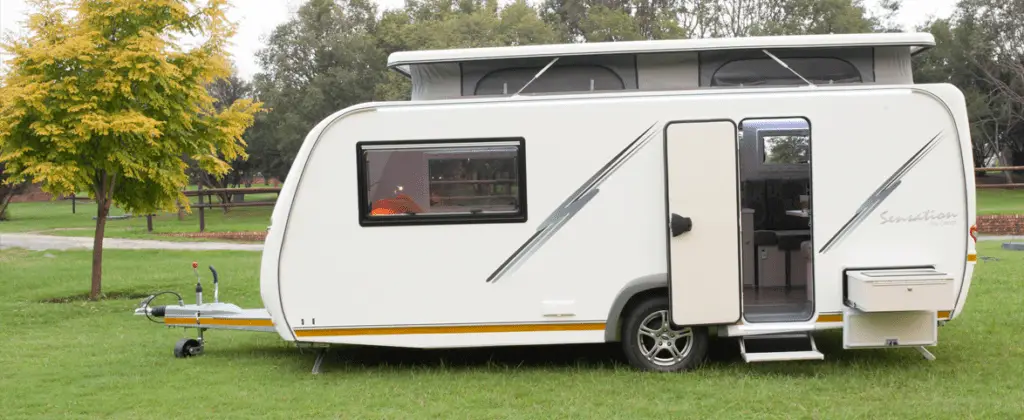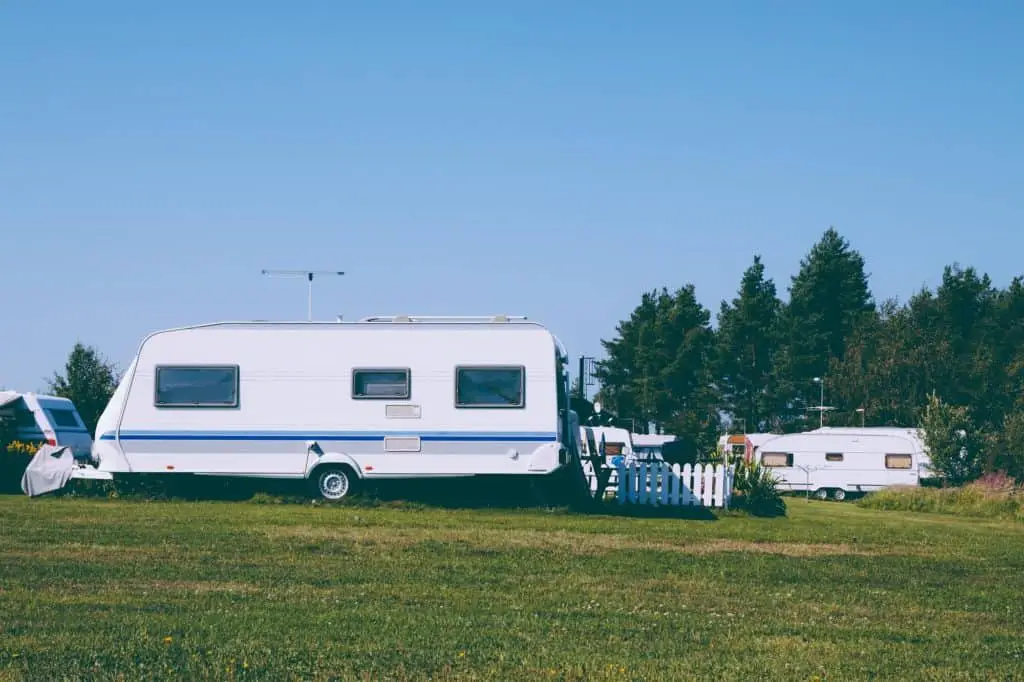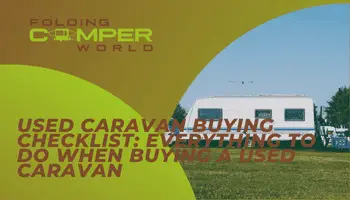As a first-time caravan buyer, you may have chosen to buy a used caravan. This is a sensible idea if you’re unsure whether caravanning is something you would like to stick to for an extended period. Investing in a used caravan before spending thousands on an expensive brand new caravan is a great way to figure out if you will enjoy caravanning enough to invest a lot of money into a new caravan. Whatever your reasoning for purchasing a used caravan, it’s crucial that you check the caravan, including the interior, the exterior and its service history. These are just some of the essential things to check; there are many other important aspects of a caravan to check before you purchase it, especially since it is a used caravan.
When buying a used caravan, you have to ensure that you’re checking for anything in the caravan that could significantly affect its value and overall condition. This can be more difficult than it sounds, as there are so many aspects of a caravan. Each of them needs checking before you purchase the caravan to ensure it meets your expectations and matches the description of the seller’s advertisement. In this blog post, I will be creating an extensive checklist that you can take along with you when viewing a used caravan to ensure everything is in good working condition. I will also be giving tips on things to do before you look for a used caravan and ensuring you know your consumer rights after you have purchased your used caravan.
This blog post will cover the following:
Preparation before looking for a caravan

When buying a used caravan for the first time, it’s important to consider and understand several critical things that will help you make the right decision on what kind of caravan you need. This will help you narrow the choices of used caravans available on the market, making it easier for you to decide and making the entire process less overwhelming.
Caravan and towing vehicle weights
The first thing to understand is which caravans your car can tow safely. Remember, your vehicle should weigh more than your caravan to tow safely. To check that your car is heavier than your caravan, you must check its kerbweight. This is the weight of the car and the vital fluids that go inside it, such as the diesel, oil, coolants and air conditioning gases etc. However, it does not include the weight of you and your family, pets and luggage.
The other vital piece of information you need before determining whether your car can tow your potential caravan is the MTPLM (Maximum Technically Permissible Laden Mass) of the caravan. This is the weight the manufacturer says is the maximum to which you safely can load the caravan. The MTPLM can be found in the handbook, which comes with it on the manufacturer’s websites.
Once you have the kerbweight of the car and the MTPLM of the caravan, you can calculate where the car is safe to tow the caravan. If the mass of the caravan is 85% or less of the car’s kerbweight, you can very easily tow your caravan. If it’s between 85% and 100%, it would be best if only experienced caravanners use this car to tow the caravan. Finally, if the caravan is heavier than the car, then it is strongly recommended not to use this car to tow the caravan as it can result in serious issues while driving.
Caravan layout
To find a used caravan that will best match your family’s needs, you must think about which kind of layout you need. If you skip this step and pick any caravan without paying attention to the layout, it can feel quite uncomfortable for your family and may not work for you, which could be quite an expensive mistake to make. Here are some questions to ask yourself to figure out which layout is best for you:
Who will be sleeping in the caravan?
It’s important to think about how many people will be sleeping in the caravan, as this will determine how many beds/ berths you need.
What will you do with the caravan?
If you’re keen on outdoor sports, such as kayaking or mountain biking, you’ll need a different layout from someone who wants a less active holiday.
Thinking about these things will make choosing a suitable caravan layout easier as you will have narrowed down your choices.
Things to check when viewing

It’s important to consider the risks of buying a used caravan. The biggest one is that it may come with issues such as damaged parts that the seller may try to hide. This is why it’s important to check the caravan’s condition and if it is worth purchasing. I asked online forum users on Caravan Talk if they have any experience buying a used caravan and if they had any advice on what sort of things to ask the seller. User ‘KnausCol’ said:
“Assess the people selling as well as the van. How well they have cared for and maintained the van will have a significant impact on its overall condition. If you can, take someone more familiar with caravans to offer some support and advice.”
When you view a used caravan, this checklist will be convenient to make sure you check every aspect of the caravan.
Important paperwork
| Caravan owner manual | |
| Heating and hot water operation | |
| Fridge and cooker paperwork | |
| Installed security items | |
| Motormover if installed | |
| Caravan history documents | |
| Check the CRiS certificate for current owner details. |
Caravan body
| Look at the bodywork for dents, chips and missing paint. | |
| Check sealant where panels join, the awnings rail and lockers. | |
| Open each locker, check the keys fit, and the locks are not broken. While open, check for cracks and foul odours. Make sure the seals are in good condition too. | |
| Check for stickers or reflectors that look out of place. These can be hiding damage. | |
| Check the windows for deep scratches, cracks or broken corners. | |
| Check for condensation | |
| On each window, check the CRiS registration number is the same as the weight plate on the side of the caravan. | |
| Using a step ladder, investigate the roof, check all roof lights are not cracked and the rubbers have not perished. | |
| While on the roof, check for sealant around fixtures suck as TV antennas and any joins on the roof panel |
Wheels and tyres
| Check the age of the tyre. Search for DOT and four numbers. (e.g.) DOT 2609 – Tyre was manufactured on week 26 in 2009 | |
| Check the condition of the tyre, no cracks/bulges or cuts. | |
| Check each tyre is the same make and size. | |
| Check for a locking wheel nut and that there is a key to release it. | |
| Check for an AL-KO wheel secure security device that fits and has keys to remove it. | |
| Check the spare tyre. |
Gas, road lights and leisure battery
| Connect a towing vehicle and check all the rear lights are working. This includes brakes, indicators, reversing, fog and all sidelights. | |
| Check the lens of the lights to make sure they are not cracked or damaged. | |
| Check that no condensation is in any of the light clusters. | |
| Check plugs for corroded pins and that no bent pins exist. | |
| Check the leisure battery for corrosion on the terminals. | |
| Check the battery for any bulges, bad smell or signs of leakage. | |
| In the gas locker, look for a date stamp on the gas pipe – this should be under five years of age. |
Chasis, floor and hitch
| Check under the caravan for corrosion. | |
| Check for any apparent bends or dents in the chassis. | |
| Use a torch to check for cracks or splinters in the wooden floor. | |
| Check no cables or fixtures are loose under the caravan. | |
| Ensure any vents in the floor are clear and free from obstruction. | |
| Check for any splits or cracks in the A-frame moulding at the hitch. | |
| Check the hitch head handle lifts correctly, and if fitted, the stabilising hitch moves freely. | |
| Check that the breakaway cable has no splits or frayed ends and has no damage to the length of the cable. If it does, this will need replacing before you tow as it is a legal requirement. | |
| Check the rubber gaiter around the damper is not split. | |
| Ensure the jockey wheel moves freely without a “grinding” feeling as it moves | |
| Check the hitch for apparent signs of damage, bends or dents. |
Inside the caravan
| Smell the air in the caravan, take note of solid or musty smells and their location | |
| Check around each window and look for stains caused by water. | |
| Open each window and check the window latches are in not broken. | |
| Use a damp meter to perform a damp check around any holes in the caravan, i.e. windows, doors and lockers. (look for damp readings below 20% on a dry day) | |
| Use a torch and look under beds and seating areas for signs of mould. | |
| Use your finger to check for damp in corners and challenging areas to see | |
| Pull up carpets, mats and any covering on the floor, walk the length of the caravan and check for any spongy flooring. The floor should be firm and not bounce. | |
| Check carpets and flooring for stains. | |
| Check upholstery for stains, marks and tears on the front and back of each cushion/seat pad. | |
| Sit in each seat and check that all seat pads are not flat or have lost their bounce. | |
| If the caravan has a bunk, make sure this has the mattress and bed boards to prevent a child falling out. | |
| Check the worksurfaces for holes, chips, scratches or broken edges. | |
| Look at each locker door and check for damage to the front. Check the handles and latches are also not broken. | |
| Open and close every locker and cupboard. Check for smooth operation and proper closure. |
Appliances
| Check the fridge and freezer work on all modes. | |
| Check all fridge shelves are present and not damaged. | |
| Look for mould around fridge door seals and freezer compartment seals. | |
| Check the fridge door closes correctly and it seals tight. | |
| Look for any damage around plastic salad trays or door shelves. | |
| Check the cooker hob igniter works. | |
| Check each gas ring that lights and holds a steady blue flame. | |
| Ignite the grill. Make sure it also lights and stays lit with a steady blue flame. | |
| Ignite the oven and make sure the oven stays lit again with a flame | |
| Make sure the grill pan, with the handle, are present. | |
| Check the shelves are fitted in the oven. | |
| Check the toilet flush is operational. | |
| Check the condition of the toilet cassette, and look for damage to the seal. | |
| Make sure the toilet bowl is not cracked or damaged |
Heating and water temperature control
| Check for heat from vents. | |
| If Alde wet heating, check for pump noise from the expansion tank | |
| Listen for strange noises whilst the caravan is warming up. | |
| Check that hot water is available from the kitchen, washroom and showerhead. | |
| Run each tap on hot and cold, check for leaks and look for damp spots under the cabinets | |
| Look at the kitchen sink, and check for cracks or leaks around the plughole. | |
| Check the washroom basin for cracks around the bowl. | |
| Look at the shower tray and check for any cracks or sealants missing. | |
| If installed, use the fire and make sure it heats up correctly. | |
| Listen to the water pump (external and internal pumps) for strange rattles or vibrations. | |
| Look at the furnace inside the caravan, and check for leaks or signs of water damage. |
Power sources
| Check that the 230v electrics are working. Check all outlets are working correctly by plugging in an appliance such as a small lamp. | |
| Switch all lights on and off that are 230v operated | |
| Check over the consumer unit, and check for any tripped circuit breaker. | |
| Check all lights, LED lighting, reading lamps and downlighters that are 12v operated. | |
| Check all USB sockets and 12v sockets are working correctly. | |
| Check the battery level indicator is operational on the main panel. | |
| On the main panel, check that there are no error messages or warnings. | |
| While unplugged, check the Electric hook up cable for damage to the plugs and cable. | |
| Check all fuses are in good order, pull each one individually and examine | |
| (If installed) check the solar panel is working correctly by examining the solar controller for lights/error codes |
In addition to checking the things listed above, you may also want to ask the seller a few questions. Take a look at our blog post ‘What questions to ask when buying a used caravan’ to get a good idea of the kind of question you should ask.
Consumer rights after purchase

It’s vital that you know your consumer rights before purchasing a used caravan. Your rights last for two years after delivery of the goods, and whatever you are buying must correspond to what they’ve said on the contract of the sale.
According to the Sale of Consumer Goods Regulations, “If the goods do not correspond to the contract, consumers can ask for the goods to be repaired, replaced, and reduced in price or for the contract to be annulled.”
Especially for a private sale, your responsibility for the caravan begins when you tow it away on a public road. If you buy from a private seller, they only have to make sure the caravan is ‘as described’. This is why it’s best to check the caravan before you tow it away when you’ve agreed on the sale. Hopefully, using the checklist provided in this blog post, you can ensure that your caravan is in good working condition.


